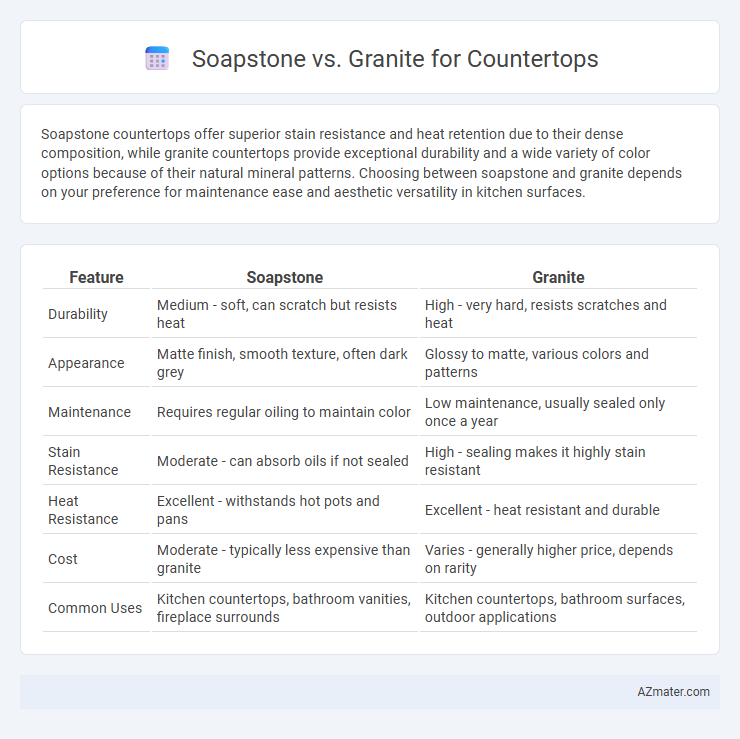Soapstone countertops offer superior stain resistance and heat retention due to their dense composition, while granite countertops provide exceptional durability and a wide variety of color options because of their natural mineral patterns. Choosing between soapstone and granite depends on your preference for maintenance ease and aesthetic versatility in kitchen surfaces.
Table of Comparison
| Feature | Soapstone | Granite |
|---|---|---|
| Durability | Medium - soft, can scratch but resists heat | High - very hard, resists scratches and heat |
| Appearance | Matte finish, smooth texture, often dark grey | Glossy to matte, various colors and patterns |
| Maintenance | Requires regular oiling to maintain color | Low maintenance, usually sealed only once a year |
| Stain Resistance | Moderate - can absorb oils if not sealed | High - sealing makes it highly stain resistant |
| Heat Resistance | Excellent - withstands hot pots and pans | Excellent - heat resistant and durable |
| Cost | Moderate - typically less expensive than granite | Varies - generally higher price, depends on rarity |
| Common Uses | Kitchen countertops, bathroom vanities, fireplace surrounds | Kitchen countertops, bathroom surfaces, outdoor applications |
Introduction to Soapstone and Granite Countertops
Soapstone countertops, composed primarily of talc and calcium carbonate, offer a smooth, heat-resistant surface that develops a unique patina over time, enhancing its natural beauty and durability. Granite countertops, formed from quartz, feldspar, and mica, are renowned for their hardness, wide range of colors, and natural veining, providing a robust and scratch-resistant surface ideal for kitchens. Both materials deliver distinct aesthetic and functional benefits, with soapstone favored for its softness and warmth, while granite is prized for its strength and diverse appearance.
Key Differences Between Soapstone and Granite
Soapstone countertops feature a smooth, matte surface that is naturally resistant to heat and stains, while granite offers a glossy, polished finish known for its exceptional hardness and durability. Soapstone is softer and can develop a unique patina over time, requiring periodic oiling to maintain its appearance, whereas granite is more scratch-resistant and less porous, reducing the need for frequent sealing. The color palette of soapstone tends toward dark grays and greens with subtle veining, contrasting with granite's wide range of colors and intricate patterns, making each material distinct in aesthetics and maintenance.
Appearance and Color Variations
Soapstone countertops feature a smooth, matte finish with natural veining in shades of gray, black, and green, offering a classic, uniform look that evolves with age. Granite provides a broader spectrum of colors, including whites, pinks, reds, browns, and blacks, characterized by speckled or marbled patterns created by mineral deposits, delivering a more vibrant and diverse appearance. The unique veining in soapstone creates subtle elegance, while granite's pronounced color variations add boldness and dynamic visual interest to kitchen designs.
Durability and Strength Comparison
Soapstone offers excellent durability with its resistance to heat, stains, and acids, making it less prone to scratches but comparatively softer than granite. Granite exhibits superior strength and hardness, providing enhanced resistance to impacts and everyday wear while maintaining a high level of durability. Both materials require proper sealing and maintenance to preserve their longevity and appearance in countertop applications.
Maintenance and Care Requirements
Soapstone countertops demand minimal maintenance, as they resist stains and bacteria without requiring sealants, but they benefit from periodic oiling to enhance their natural patina. Granite countertops need routine sealing to prevent stains and bacterial infiltration, with cleaning best done using a pH-balanced cleaner to avoid damaging the stone's surface. Both materials require non-abrasive cleaning methods, but soapstone's softer composition makes it more prone to scratches, which can be sanded out, whereas granite's hardness offers superior scratch resistance.
Cost Analysis: Soapstone vs Granite
Soapstone countertops typically cost between $70 and $120 per square foot, including installation, offering a moderate-priced option with durability and unique veining. Granite prices range from $40 to $100 per square foot, with premium slabs and complex patterns driving costs higher, making it a more flexible choice for various budgets. Both materials require periodic sealing, but granite's wider price range allows for more budget-conscious selections compared to the consistently mid to high price point of soapstone.
Installation Process and Considerations
Soapstone countertops are softer and easier to cut, making their installation more forgiving and suitable for DIY projects, while granite requires precise cutting and professional handling due to its hardness and brittleness. Soapstone's uniform density reduces the risk of chipping during installation, whereas granite demands expert measurement and heavy-duty tools to handle its weight and ensure seamless fitting. Both materials require sealing, but granite often needs more frequent maintenance to prevent staining and preserve its polished finish.
Environmental Impact and Sustainability
Soapstone countertops offer a lower environmental impact due to their natural composition, durability, and minimal processing requirements compared to granite. Granite extraction involves extensive quarrying and energy-intensive processes that contribute to higher carbon emissions and habitat disruption. Choosing soapstone supports sustainability through its longevity, resistance to chemicals, and reduced need for sealants or treatments.
Pros and Cons of Soapstone Countertops
Soapstone countertops offer natural resistance to heat, stains, and bacteria, making them ideal for kitchen use, but they are softer and more prone to scratches than granite. Their rich, smooth texture and unique veining develop a patina over time, enhancing aesthetic appeal while requiring regular oiling to maintain. Unlike granite, soapstone is less brittle and does not require sealing, but its limited color range and higher susceptibility to physical wear may not suit all design preferences.
Pros and Cons of Granite Countertops
Granite countertops offer exceptional durability and resistance to heat, scratches, and stains, making them ideal for high-traffic kitchen areas. Their natural variegated appearance and wide color range enhance aesthetic appeal, while requiring periodic sealing to maintain stain resistance. However, granite's hardness can make it prone to chipping along edges, and installation costs tend to be higher compared to other countertop materials.

Infographic: Soapstone vs Granite for Countertop
 azmater.com
azmater.com